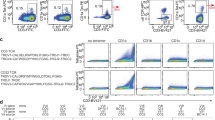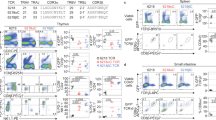Abstract
αβ T lymphocytes are able to detect even a single peptide–major histocompatibility complex (MHC) on the surface of an antigen-presenting cell1,2. This is despite clear evidence, at least with CD4+ T cells, that monomeric ligands are not stimulatory3,4. In an effort to understand how this remarkable sensitivity is achieved, we constructed soluble peptide–MHC heterodimers in which one peptide is an agonist and the other is one of the large number of endogenous peptide–MHCs displayed by presenting cells. We found that some specific combinations of these heterodimers can stimulate specific T cells in a CD4-dependent manner. This activation is severely impaired if the CD4-binding site on the agonist ligand is ablated, but the same mutation on an endogenous ligand has no effect. These data correlate well with analyses of lipid bilayers and cells presenting these ligands, and indicate that the basic unit of helper T cell activation is a heterodimer of agonist peptide– and endogenous peptide–MHC complexes, stabilized by CD4.
This is a preview of subscription content, access via your institution
Access options
Subscribe to this journal
Receive 51 print issues and online access
$199.00 per year
only $3.90 per issue
Buy this article
- Purchase on Springer Link
- Instant access to full article PDF
Prices may be subject to local taxes which are calculated during checkout




Similar content being viewed by others
References
Irvine, D. J., Purbhoo, M. A., Krogsgaard, M. & Davis, M. M. Direct observation of ligand recognition by T cells. Nature 419, 845–849 (2002)
Purbhoo, M. A., Irvine, D. J., Huppa, J. B. & Davis, M. M. T cell killing does not require the formation of a stable mature immunological synapse. Nature Immunol. 5, 524–530 (2004)
Boniface, J. J. et al. Initiation of signal transduction through the T cell receptor requires the multivalent engagement of peptide/MHC ligands. Immunity 9, 459–466 (1998); erratum 9, 891
Cochran, J. R., Cameron, T. O. & Stern, L. J. The relationship of MHC-peptide binding and T cell activation probed using chemically defined MHC class II oligomers. Immunity 12, 241–250 (2000)
Tanchot, C., Lemonnier, F. A., Perarnau, B., Freitas, A. A. & Rocha, B. Differential requirements for survival and proliferation of CD8 naive or memory T cells. Science 276, 2057–2062 (1997)
Ernst, B., Lee, D. S., Chang, J. M., Sprent, J. & Surh, C. D. The peptide ligands mediating positive selection in the thymus control T cell survival and homeostatic proliferation in the periphery. Immunity 11, 173–181 (1999)
Stefanova, I., Dorfman, J. R. & Germain, R. N. Self-recognition promotes the foreign antigen sensitivity of naive T lymphocytes. Nature 420, 429–434 (2002)
Wulfing, C. et al. Costimulation and endogenous MHC ligands contribute to T cell recognition. Nature Immunol. 3, 42–47 (2002)
Sporri, R. & Reis e Sousa, C. Self peptide/MHC class I complexes have a negligible effect on the response of some CD8 + T cells to foreign antigen. Eur. J. Immunol. 32, 3161–3170 (2002)
Davis, M. M. et al. Ligand recognition by αβT cell receptors. Annu. Rev. Immunol. 16, 523–544 (1998)
Marrack, P., Ignatowicz, L., Kappler, J. W., Boymel, J. & Freed, J. H. Comparison of peptides bound to spleen and thymus class II. J. Exp. Med. 178, 2173–2183 (1993)
Schild, H. et al. Natural ligand motifs of H-2E molecules are allele specific and illustrate homology to HLA-DR molecules. Int. Immunol. 7, 1957–1965 (1995)
Lee, S. J., Hori, Y., Groves, J. T., Dustin, M. L. & Chakraborty, A. K. Correlation of a dynamic model for immunological synapse formation with effector functions: two pathways to synapse formation. Trends Immunol. 23, 492–499 (2002)
Tsien, R. Y. Fluorescent probes of cell signaling. Annu. Rev. Neurosci. 12, 227–253 (1989)
Li, Q. J. et al. CD4 enhances T cell sensitivity to antigen by coordinating Lck accumulation at the immunological synapse. Nature Immunol. 5, 791–799 (2004)
Deane, J. A. & Fruman, D. A. Phosphoinositide 3-kinase: diverse roles in immune cell activation. Annu. Rev. Immunol. 22, 563–598 (2004)
Huppa, J. B., Gleimer, M., Sumen, C. & Davis, M. M. Continuous T cell receptor signaling required for synapse maintenance and full effector potential. Nature Immunol. 4, 749–755 (2003)
Wettstein, D. A., Boniface, J. J., Reay, P. A., Schild, H. & Davis, M. M. Expression of a class II major histocompatibility complex (MHC) heterodimer in a lipid-linked form with enhanced peptide/soluble MHC complex formation at low pH. J. Exp. Med. 174, 219–228 (1991)
Schild, H. et al. The nature of major histocompatibility complex recognition by gamma delta T cells. Cell 76, 29–37 (1994)
Sumen, C., Dustin, M. L. & Davis, M. M. T cell receptor antagonism interferes with MHC clustering and integrin patterning during immunological synapse formation. J. Cell Biol. 166, 579–590 (2004)
Miceli, M. C. & Parnes, J. R. Role of CD4 and CD8 in T cell activation and differentiation. Adv. Immunol. 53, 59–122 (1993)
Konig, R., Huang, L. Y. & Germain, R. N. MHC class II interaction with CD4 mediated by a region analogous to the MHC class I binding site for CD8. Nature 356, 796–798 (1992)
Cammarota, G. et al. Identification of a CD4 binding site on the β2 domain of HLA-DR molecules. Nature 356, 799–801 (1992)
Wu, L. C., Tuot, D. S., Lyons, D. S., Garcia, K. C. & Davis, M. M. Two-step binding mechanism for T-cell receptor recognition of peptide MHC. Nature 418, 552–556 (2002)
Delon, J. et al. CD8 expression allows T cell signaling by monomeric peptide-MHC complexes. Immunity 9, 467–473 (1998)
Ge, Q. et al. Soluble peptide-MHC monomers cause activation of CD8 + T cells through transfer of the peptide to T cell MHC molecules. Proc. Natl Acad. Sci. USA 99, 13729–13734 (2002)
Aivazian, D. & Stern, L. J. Phosphorylation of T cell receptor ζ is regulated by a lipid dependent folding transition. Nature Struct. Biol. 7, 1023–1026 (2000)
Sun, Z. J., Kim, K. S., Wagner, G. & Reinherz, E. L. Mechanisms contributing to T cell receptor signaling and assembly revealed by the solution structure of an ectodomain fragment of the CD3ɛγ heterodimer. Cell 105, 913–923 (2001)
Krogsgaard, M. et al. Evidence that structural rearrangements and/or flexibility during TCR binding can contribute to T-cell activation. Mol. Cell 12, 1367–1378 (2003)
Fremont, D. H., Hendrickson, W. A., Marrack, P. & Kappler, J. Structures of an MHC class II molecule with covalently bound single peptides. Science 272, 1001–1004 (1996)
Acknowledgements
We thank J. D. Stone and L. Stern for providing the crosslinker reagent to initiate these studies as well as for helpful discussions. We thank B. Lillemeier for Baculovirus DNA encoding His-tagged ICAM-1 and B7-1. We thank C. Schæfer-Nielsen, M. Kuhns, A. Krogsgaard and members of the Davis and Chien laboratory for helpful discussions. We thank K. C. Garcia and M. Winslow for critical reading of the manuscript and helpful discussions and analysis. We thank N. Prado and B. Smith for technical assistance. M.K. was a postdoctoral fellow of the Alfred Benzon Foundation and the Danish Medical Research Council. Q.L. and M.H. are supported by Helen Hay Whitney Foundation Fellowships. This work is supported by grants from the NIH and from the Howard Hughes Medical Institute.
Author information
Authors and Affiliations
Corresponding author
Ethics declarations
Competing interests
The authors declare that they have no competing financial interests.
Supplementary information
Supplementary Notes
This file contains legends to accompany Supplementary Figures S1-S7 and Supplementary Movies S1-S5. This file also contains Supplementary Methods and additional References. (DOC 35 kb)
Supplementary Figure S1
Accumulation analysis of endogenous/null MCC-derived peptides. (PDF 1712 kb)
Supplementary Figure S2
Binding and stability analysis of endogenous/null and MCC-derived peptides. (PDF 283 kb)
Supplementary Figure S3
Functional characterization of generated pMHC dimers. SDS-PAGE analysis and T-cell activation (Ca2+) analysis. (PDF 1781 kb)
Supplementary Figure S4
T-cell activation potency (Ca2+ and PI3K) and binding affinity of pMHC dimers. (PDF 358 kb)
Supplementary Figure S5
Effect of endogenous peptides when presented by membrane-associated MHC on the surface of CHO cells or in supported lipid bilayers. (PDF 360 kb)
Supplementary Figure S6
Effect on endogenous-agonist pMHC dimer induced T-cell activation by ablating CD4 binding with a CD4 blocking antibody or CD4 binding mutations. (PDF 216 kb)
Supplementary Figure S7
Effect on null-agonist pMHC dimer induced T-cell activation by ablating CD4 binding with CD4 binding mutations. (PDF 224 kb)
Supplementary Videos S1
Ca2+ response and PH(Akt)-YFP localization in 5C.C7 T cells in response to pMHC dimers. (MOV 416 kb)
Rights and permissions
About this article
Cite this article
Krogsgaard, M., Li, Qj., Sumen, C. et al. Agonist/endogenous peptide–MHC heterodimers drive T cell activation and sensitivity. Nature 434, 238–243 (2005). https://doi.org/10.1038/nature03391
Received:
Accepted:
Published:
Issue Date:
DOI: https://doi.org/10.1038/nature03391
This article is cited by
-
Catch bond models may explain how force amplifies TCR signaling and antigen discrimination
Nature Communications (2023)
-
Controlling T cells spreading, mechanics and activation by micropatterning
Scientific Reports (2021)
-
Analysis of the Expression of the TRBC1 in T lymphocyte tumors
Indian Journal of Hematology and Blood Transfusion (2021)
-
Targeting the Hsp90-Cdc37-client protein interaction to disrupt Hsp90 chaperone machinery
Journal of Hematology & Oncology (2018)
-
Phosphoinositides regulate the TCR/CD3 complex membrane dynamics and activation
Scientific Reports (2018)
Comments
By submitting a comment you agree to abide by our Terms and Community Guidelines. If you find something abusive or that does not comply with our terms or guidelines please flag it as inappropriate.



